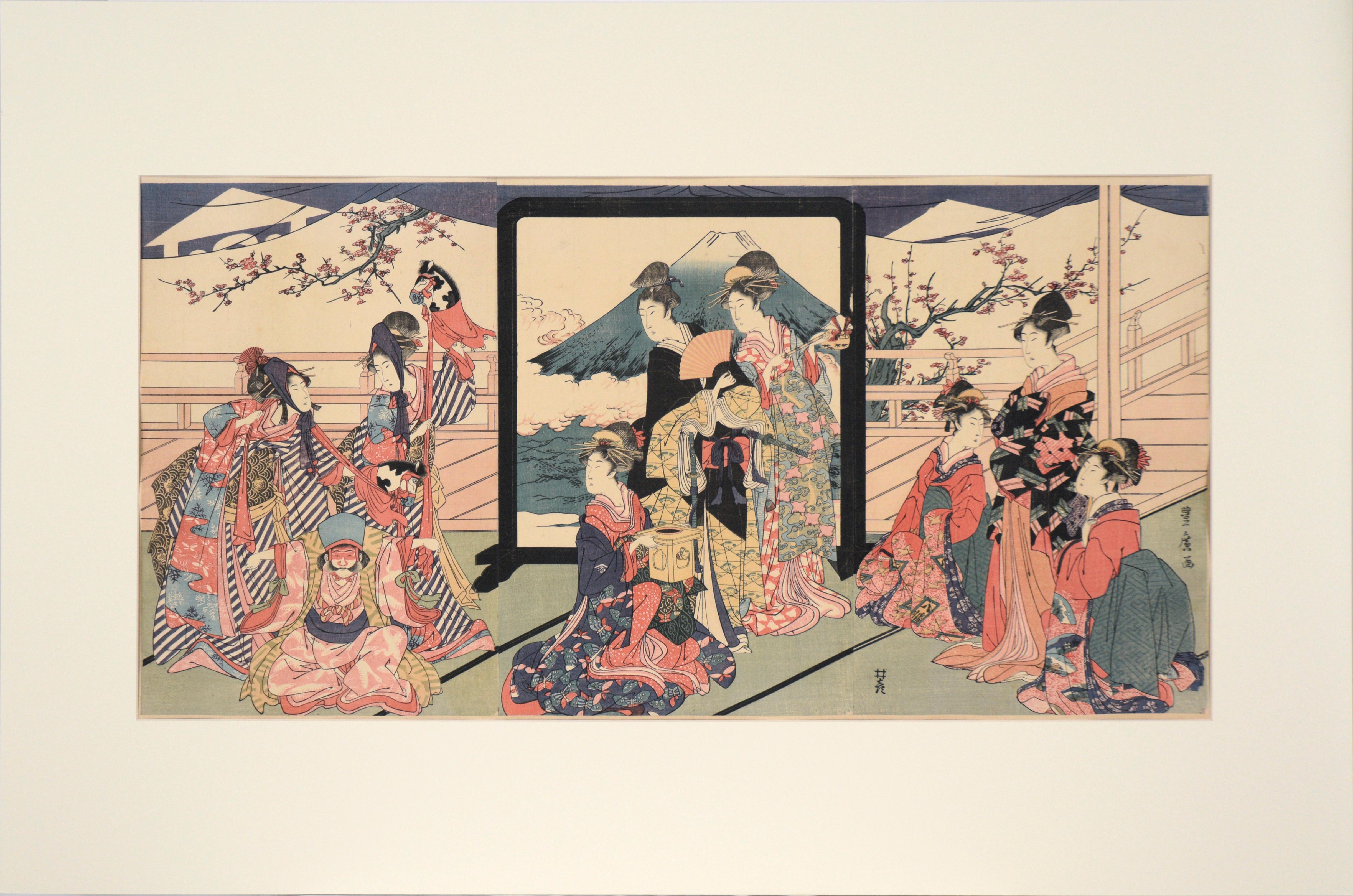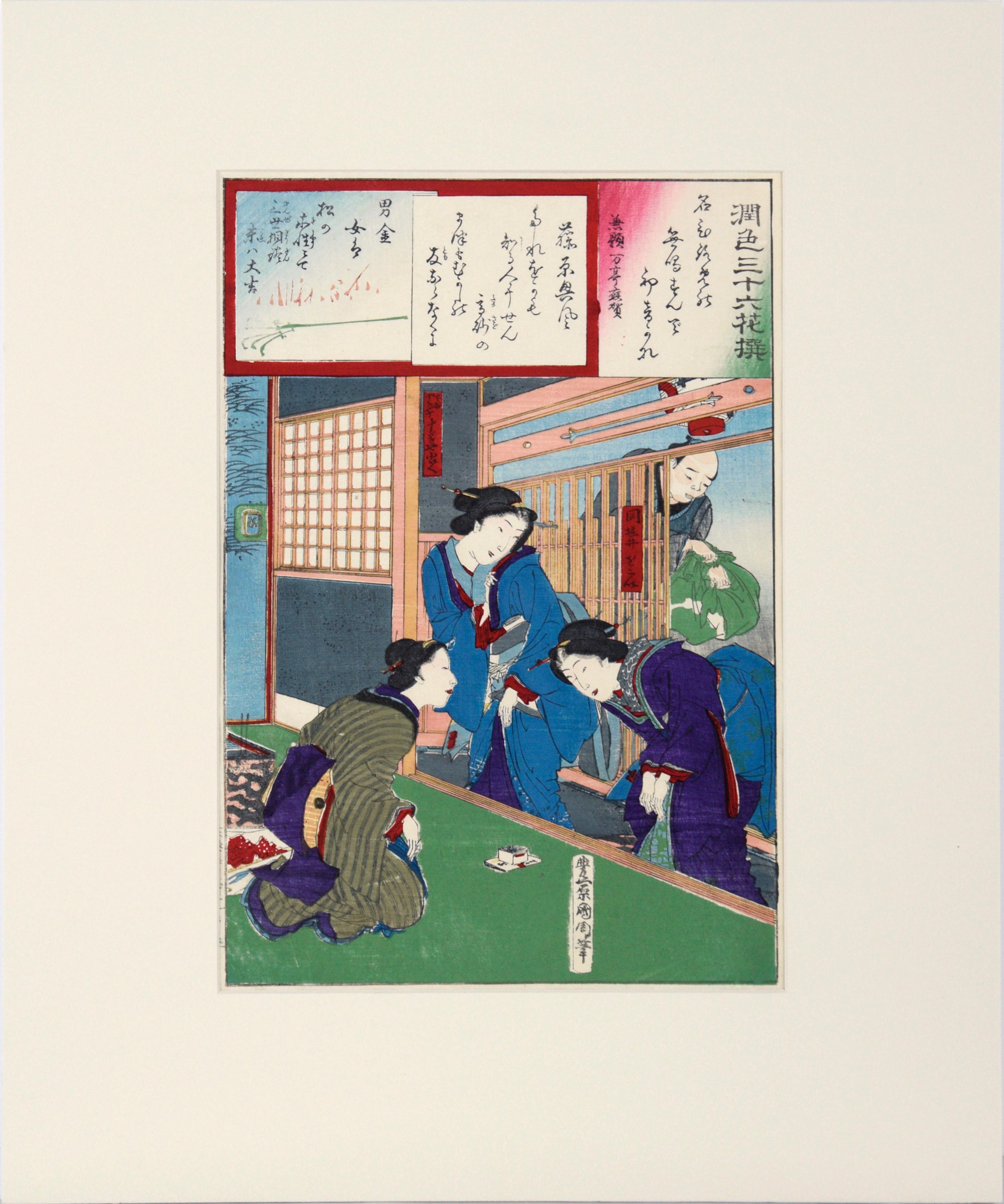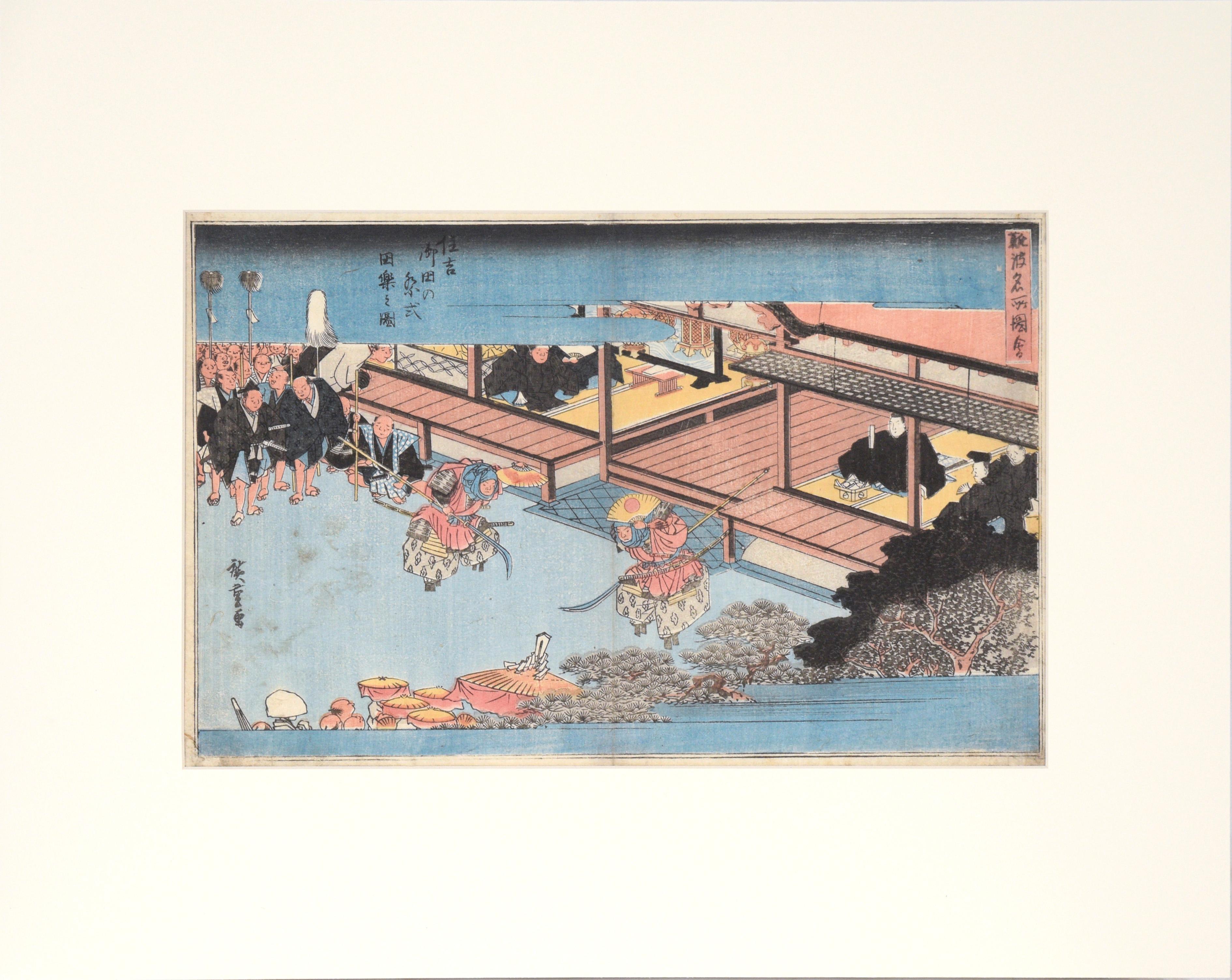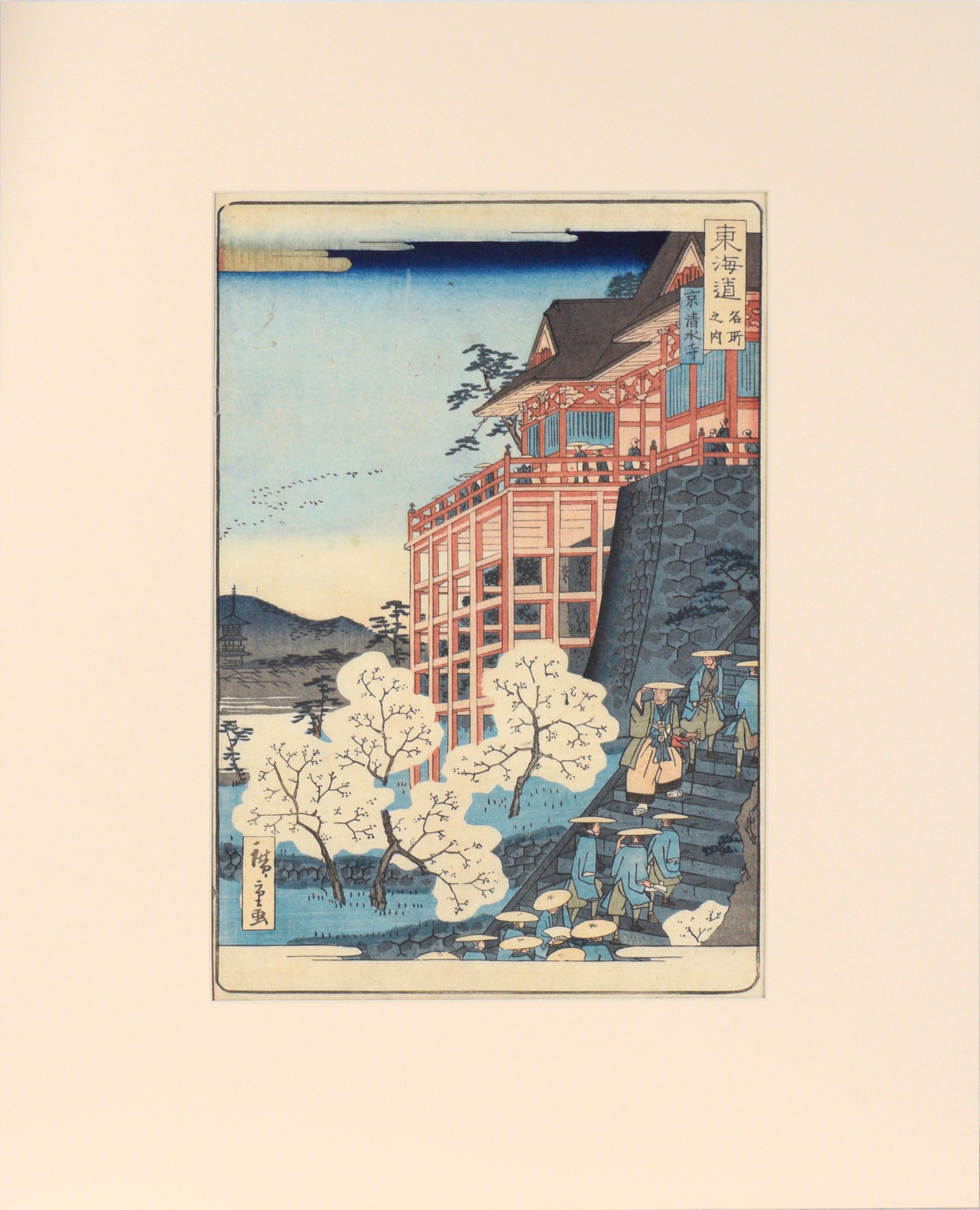Items Similar to Kabuki Actor in Blue Kimono - Original Woodblock Print
Want more images or videos?
Request additional images or videos from the seller
1 of 11
Suzuki HarunobuKabuki Actor in Blue Kimono - Original Woodblock Print1700's
1700's
About the Item
Kabuki Actor in Blue Kimono - Original Woodblock Print
Original woodblock print depicting a Kabuki actor in a blue kimono by Suzuki Harunobu (Japanese, 1725-1770). The actor holds up a sword in his left hand while his right hand is tied in a black rope.
Presented in a wood frame.
Frame: 21.5"H x 16.5"W
Paper: 20.75"H x 15.75"W
Image: 14"H x 10"W
Suzuki Harunobu thus became one of the primary producers of images of bijinga (pictures of beautiful women) and kabuki actors of Edo, and of similar and related subjects for the Edo print connoisseur market. In a few special cases, notably his famous set of eight prints entitled Zashiki hakkei (Eight Parlor Views), the patron's name appears on the print along with, or in place of, Harunobu's own. The presence of a patron's name or seal, and especially the omission of that of the artist, was another novel development in ukiyo-e of this time.
Between 1765 and 1770, Harunobu created over twenty illustrated books and over one thousand color prints, along with a number of paintings. He came to be regarded as the master of ukiyo-e during these last years of his life, and was widely imitated until, a number of years after his death, his style was eclipsed by that of new artists, including Katsukawa Shunshō and Torii Kiyonaga.
In addition to the revolutionary innovations that came with the introduction of nishiki-e, Harunobu's personal style was unique in a number of other respects. His figures are all very thin and light; some critics say that all his figures look like children. However, it is these same young girls who epitomize Harunobu's personal style. Richard Lane describes this as "Harunobu's special province, one in which he surpassed all other Japanese artists - eternal girlhood in unusual and poetic settings". Though his compositions, like most ukiyo-e prints, may be said to be fairly simple overall, it is the overall composition that concerned Harunobu. Unlike many of his predecessors, he did not seek to have the girls' kimono dominate the viewer's attention.
- Creator:Suzuki Harunobu
- Creation Year:1700's
- Dimensions:Height: 21.5 in (54.61 cm)Width: 16.5 in (41.91 cm)Depth: 0.5 in (1.27 cm)
- Medium:
- Movement & Style:
- Period:1760-1769
- Condition:Good condition. Some fading and age toning to paper. Water stains to linen mat.
- Gallery Location:Soquel, CA
- Reference Number:
About the Seller
4.9
Platinum Seller
These expertly vetted sellers are 1stDibs' most experienced sellers and are rated highest by our customers.
Established in 1986
1stDibs seller since 2014
2,542 sales on 1stDibs
Typical response time: <1 hour
- ShippingRetrieving quote...Ships From: Soquel, CA
- Return PolicyA return for this item may be initiated within 14 days of delivery.
More From This SellerView All
- "Toy Horse Dance" Japanese Woodblock Triptych with Beauties and Mt FujiLocated in Soquel, CA"Toy Horse Dance" Japanese Woodblock Triptych with Beauties and Mt Fuji Vibrant three-panel woodblock print by Utagawa Toyohiro (Japanese,...Category
Early 20th Century Edo Figurative Prints
MaterialsWoodcut, Rice Paper, Ink
- "Enshoku Sanju-roku Kasen" (Thirty-six Enchanting Flowers) Woodblock on paperBy Toyohara KunichikaLocated in Soquel, CA"Enshoku Sanju-roku Kasen" (Thirty-six Enchanting Flowers) Woodblock on paper Elegant woodblock print by Toyohara Kunuchika (Japanese, 1835-1900). Three women are in talking with each other inside, while a man waits outside holding a bag of some kind. The colors in this piece are rich and saturated, primarily blues, greens, and purple. Mat size: 16"H x 20"W Paper size: 14.75"H x 9.88"W Born in 1835, Toyohara Kunichika grew up in the Kyobashi district of Edo in the midst of merchants and artisans. In 1848, at age 13, he was accepted as an apprentice into the studio of Utagawa Kunisada I...Category
1880s Edo Figurative Prints
MaterialsInk, Rice Paper, Woodcut
- Kabuki Actor in Water Lily Robe with Samurai Sword - Japanese Woodblock PrintBy Utagawa ToyokuniLocated in Soquel, CAKabuki Actor in Water Lily Robe with Samurai Sword- Japanese Woodblock Print Finely detailed woodblock by Utagawa Toyokuni (Japanese, 1769-1825). A kabuki actor ("Master Haranyuki Sawamura") is standing on stage with mountainous backdrop, wearing a robe in a water lily pattern. He is wearing a samurai sword. Presented in a gold colored frame with a silk mat. Frame size: 20"H x 14.25"W Image size: 14"H x 9"W Utagawa Toyokuni (Japanese, 1769-1825) was born in Edo, the son of Kurahashi Gorobei, a carver of dolls and puppets...Category
Early 19th Century Edo Figurative Prints
MaterialsInk, Rice Paper, Woodcut
- "First Horse Day, 1896" - Chiyoda Palace - Japanese Woodblock by Chikanobu YoshuBy Toyohara ChikanobuLocated in Soquel, CA"First Horse Day, 1896" - Chiyoda Palace - Japanese Woodblock by Chikanobu Yoshu Colorful and expressive court scne by Toyohara Chikanobu,"Yoshu" (Japanese, 1838-1912). This is the r...Category
1890s Edo Figurative Prints
MaterialsRice Paper, Ink, Woodcut
- Sumiyoshi: Dengaku dance performed during an Onda ceremony - Woodblock PrintBy Utagawa HiroshigeLocated in Soquel, CASumiyoshi: Dengaku dance performed during an Onda ceremony - Woodblock Print Bright woodblock print by Utagawa Hiroshige (Japanese, 1797-1858). In this scene, two dancers with swords and fans are facing each other, in the center of a courtyard. There are spectators surrounding them, including nobles in black clothing on a balcony. Presented in a new off-white mat with foamcore backing. Mat size: 16"H x 20"W Paper size: 9.63"H x 14.5W" Utagawa Hiroshige (1797-1858, sometimes called Ando Hiroshige) was the second of the two great masters of the Japanese landscape woodblock print...Category
1830s Edo Figurative Prints
MaterialsInk, Rice Paper, Woodcut
- Kiyomizu Temple, Scenes of Famous Places along Tôkaidô Road - Woodblock on PaperBy Utagawa Hiroshige IILocated in Soquel, CAKiyomizu Temple, Scenes of Famous Places along Tôkaidô Road - Woodblock on Paper Full Title: Kyoto: Kiyomizu Temple (Kyô Kiyomizudera), from the series Scenes of Famous Places along...Category
1860s Edo Landscape Prints
MaterialsInk, Rice Paper, Woodcut
You May Also Like
- Seishi Ai-oi Genji – Set of 12 Shunga works together w/astrological commentaryBy Utagawa Kunisada (Toyokuni III)Located in Middletown, NYSet of 12 woodblock prints in colors on handmade, laid mulberry paper, 6 3/4 x 10 1/4 inches (170 x 258 mm), printed in Ka-ei 4 (1851). Each print with minor handling wear, otherwise in excellent condition with bright and fresh color, and with details printed in silver ink. The images themselves contain several illusive characters indicating the publisher which are obfuscated by figures, as intended. Presented loose, as issued. A fine set. The astrological commentary print has a large and meandering blind stamp with a bird and palm frond motif. This print lists various phrases concerning the Twelve Zodiac Animals as historically counted in Japan, and appears to include erotic commentary on the traits of people born under each of the twelve signs. These Shunga images were issued in books that paralleled (in an erotic fashion...Category
Mid-19th Century Edo Nude Prints
MaterialsHandmade Paper, Ink, Woodcut
- Drying PaperLocated in Middletown, NYWoodcut on cream laid paper, 7 1/4 x 2 1/2 inches (182 x 63 mm), narrow margins. Laid down to non-archival board with scattered soiling and some adhesive staining. Okumura Masanobu (Japanese 1686 – 13 March 1764) was a Japanese print designer, book publisher, and painter. He also illustrated novelettes and in his early years wrote some fiction. At first his work adhered to the Torii school, but later drifted beyond that. He is a figure in the formative era of ukiyo-e doing early works on actors and bijin-ga ("pictures of beautiful women"). While Masanobu's early life is largely undocumented, he is believed to have been born about 1686, possibly in Edo (modern Tokyo). Edo was a small fishing village when Tokugawa Ieyasu chose it as his administrative capital of the Tokugawa shogunate, and by the early 17th century the city had prospered and its population had grown to half a million. Masanobu appears to have been self-taught painter (though he did study poetry under Tachiba Fukaku); he is not known to have belonged to any artistic school. His early work shows the influence of the Torii school of ukiyo-e painting...Category
Early 18th Century Edo Figurative Prints
MaterialsHandmade Paper, Woodcut
- Actor Iwai Shigaku as Somenoi in "Denka chaya adauchi"By KuniyoshiLocated in Middletown, NYActor Iwai Shigaku as Somenoi in "Denka chaya adauchi" (Revenge at the Denka Teahouse), by Shigeharu, Ryusai (also called Kuniyoshi) Tokyo: Horie Ichiba Wataki, 1835. Woodcut on la...Category
Early 19th Century Edo Portrait Prints
MaterialsLaid Paper, Handmade Paper, Woodcut
- Dyeing PaperLocated in Middletown, NYJapan: circa 1770. Woodcut on cream laid paper, 7 1/4 x 2 1/2 inches (182 x 63 mm), narrow margins. Laid down to non-archival board with scattered soiling and some adhesive staining...Category
Late 18th Century Edo Figurative Prints
MaterialsHandmade Paper, Woodcut, Laid Paper
- The Battle of Dan-no-ura in Yashima, Nagato Province in the First Year .....By Utagawa YoshitoraLocated in Middletown, NYThe Battle of Dan-no-ura in Yashima, Nagato Province in the First Year of the Bunji Era (1185) Tokyo c. 1830 Woodblock print (nishiki-e) with ink and hand-coloring in watercolor on handmade mulberry paper, 14 7/16 x 9 15/16 inches (367 x 252 mm), ōban tate-e, the full sheet. In good condition with some handling creases. Colors are fresh and extremely vibrant. The right panel from the triptych by Yoshitora depicting one of Japan's most storied naval battles. An impression of this work may be found in the permanent collection of the Honolulu Museum of Art. The great naval battle of Dan-no-ura in 1185 was the final climax in a long series of bitter wars between two powerful families in feudal Japan...Category
Early 19th Century Edo Figurative Prints
MaterialsHandmade Paper, Watercolor, Woodcut
- Toshogu ShrineLocated in Middletown, NYIn image of the Tokugawa family paying homage to Tosho-gu Shrine in Nikko. Tokyo: Matsuki Heikichi, 1896 Woodcut in ink with embossing and hand-coloring in watercolor on handmade m...Category
Late 19th Century Edo Figurative Prints
MaterialsHandmade Paper, Watercolor, Woodcut





